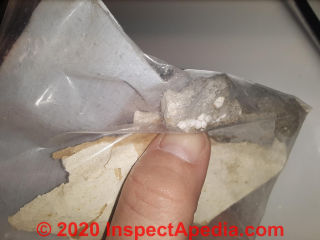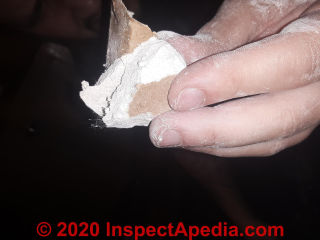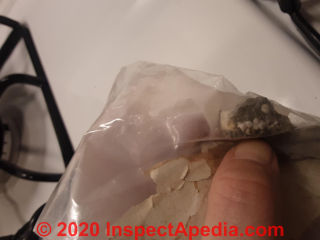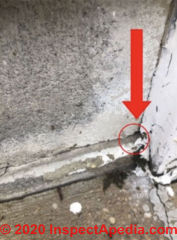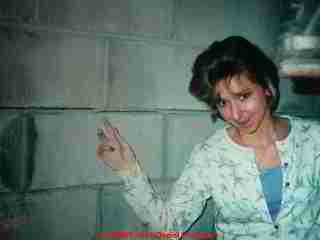 Foundation Damage & Repair Guide
Foundation Damage & Repair Guide
Foundation Cracks, Leans, Bulges, Settlement: Inspecting Foundations for Structural Defects - Detection, Diagnosis, Cause, Repair
- POST a QUESTION or COMMENT on how to evaluate, diagnose, & repair foundation cracks, leans, bulges, movement, damage
This article series describes in detail how to recognize, diagnose & repair various types of foundation failure or damage, such as foundation cracks, masonry foundation crack patterns, and moving, leaning, bulging, or bowing building foundation walls.
Types of foundation cracks, crack patterns, differences in the meaning of cracks in different foundation materials, site conditions, building history, and other evidence of building movement and damage are described to assist in recognizing foundation defects and to help the inspector separate cosmetic or low-risk conditions from those likely to be important and potentially costly to repair.
InspectAPedia tolerates no conflicts of interest. We have no relationship with advertisers, products, or services discussed at this website.
- Daniel Friedman, Publisher/Editor/Author - See WHO ARE WE?
Methods & Procedures for Evaluating Residential Structural Foundation Cracks, Movement, & Condition
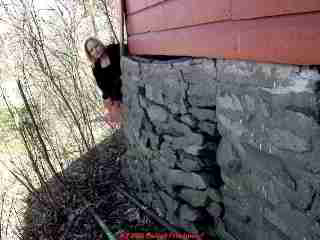
This article series explaining how to recognize, diagnose and repair foundation cracks & damage is for building owners, professional or licensed home inspectors, foundation repair companies, foundation engineers, architects, and other building professionals concerned with residential property masonry foundation failure detection, diagnosis, and repair.
Watch out: To be used properly, this information must be combined with specific on-site observations at the particular building in order to form a reliable opinion about the condition of that building's foundation. Anyone having concern regarding the structural stability, safety, or damage of a building, foundation or other components, should consult a qualified expert.
At this website we explain how it is sometimes possible to be confident about the cause of foundation damage which in turn helps assess the risk presented to the building.
Photographs of types of foundation cracks and other foundation damage: we have a large library of photographs which are constantly adding this website.
The photo above shows a cracked, bulged, leaning stone foundation wall at the edge of an embankment - a condition we discuss further at this website.
Strategy for Building Foundation or Floor or Slab Crack, Damage, or Movement Assessment
To understand the cause, effect, and remedy for all types of building foundation or masonry wall damage or movement we have categorized foundation damage into these broad categories:
- FOUNDATION DAMAGE & REPAIR GUIDE: home page for foundation damage assessment & repair procedures. Damage assessment concepts, standards.
- FOUNDATION CRACK DICTIONARY, what is the severity of foundation damage, what is its effect on the stability of the structure, and how urgently are foundation repairs needed?
- FOUNDATION FAILURES by MOVEMENT TYPE: is the movement active or not, how is the foundation moving: bulging, leaning, settling, etc. ?
- FOUNDATION FAILURES by TYPE & MATERIAL: how does damage show up in different types of foundation material & what are the implications for collapse risk or repair need?
- FOUNDATION REPAIR METHODS discusses alternative ways to fix a damaged foundation or floor slab crack or movement
The photo at page top shows a bowed masonry block foundation wall with horizontal cracking that occurred due to earth loading at the time of construction, probably by vehicles driving too close to the foundation wall shortly after it was constructed.
Foundation Inspection Objectives
Home inspectors, building code compliance inspectors, and general building contractors are often able to recognize possible foundation or other building problems which may be costly or dangerous, thus requiring the intervention of an expert foundation repair company or foundation design engineer.
These early visitors to a building site, most often the home inspector, see a very large number of in-service field conditions leading to building failures.
Foundation inspectors can, without performing any engineering calculations or analysis, learn to recognize signs of important foundation or other structural problems developing well before forensic engineers and foundation experts are asked to design a repair and almost always well before the actual occurrence of a catastrophic building failure.
This breadth of field inspection experience and education, combined with an informed and careful building inspection, provide a valuable first line of defense for building owners and occupants who may be facing previously unrecognized costly or dangerous foundation damage.
- Foundation inspections are conducted to identify & document potential costly or dangerous conditions. The inspection
must consider many factors beyond the obviously visible condition of the foundation, such as attending to site conditions,
evidence of the history of building movement, and the type, location, and extent of cracking and movement.
This data, combined with education and experience, permit a knowledgeable foundation inspector to advise the client about the urgency of foundation repair and the type of repair that may be needed. - Accountability: the inspector is accountable for visible portions of the foundation and for recognizing signs of defects. In some circumstances this may include invisible or hard-to-see conditions for which there are nonetheless adequate clues: contextual, historical, or other visible secondary evidence.
- Action: If appropriate, the inspector may suggest further evaluation/repair including invasive methods such as removing finish materials that cover the foundation, outside excavation, the employment of a foundation engineer, foundation repair company, a test firm to make soil borings, or other investigative measures.
- Watch out: Danger: Since certain masonry structure defects, such as bulged above ground brick masonry walls, can lead to sudden
precipitous and catastrophic collapse, dangerous conditions may be present at some properties.
While there are often hidden conditions which can disguise building conditions, the ability to recognize those potentially urgent or dangerous conditions which can be detected is important in a foundation inspection.In-service field conditions refers to the state of repair of a building or its components while the building is in-use.
Building construction standards, engineering and architectural design, and building code compliance have traditionally dealt either with advance specifications for a building which is to be constructed, or with the forensic examination of a building or component after it has failed.The science and practice of in-service building inspections and building conditions provide an important but different base of experience about the way in which buildings and building components fail, the causes of building failures, and the detection of clues indicating that failures are developing.
In-service building inspections provide an opportunity to detect evidence of developing construction failures which (usually) have not yet reached such dire conditions as to be obvious to the lay person.The home inspection profession (contrasted with the "home inspection industry") focuses on in-service field conditions and as such has developed its own unique education, standards, ethics, and practices. Yet it also requires an understanding of design, codes, and building standards as well as traditional failure analysis.
Foundation Damage Severity Assessment
How to Evaluate the Significance or Amount of Foundation Movement when a foundation is leaning, bulging, bowing, or settling
For complete details see FOUNDATION DAMAGE SEVERITY for our discussion of how to evaluate and report the severity of building foundation damage.
A few examples are provided just below.
- Historical data is a key observation or data that needs to be collected to assess the significance of any evidence of foundation movement
- New or sudden foundation movement: If foundation cracking or movement is new, recent, or sudden: serious, prompt action is needed and you should consult an expert, in particular
if the amount is more than trivial.
Trivial movement would be the discovery of a hairline crack (less than 1/16" in width) or a shrinkage crack in a building foundation wall or floor slab.
A word of caution: sometimes a crack has been present for a long time at a building but has simply not been noticed by the building owner or occupants.
The first time such a crack is seen it may be mistaken for "new" and "sudden" when that is not the case.
See our discussion of SHRINKAGE vs EXPANSION vs SETTLEMENT. - Recurrent foundation cracking or movement: action is probably needed since recurrent movement can lead to cumulative damage to some structures even if the amount of movement is not great. In particular, if you have made cosmetic repairs to a foundation or to plaster or drywall finished areas above and supported by such a foundation you may see that the cracks you repaired have simply recurred.
- Long term, continuing, but slow foundation movement: action may be needed, particularly if the effects of long term foundation movement are cumulative.
- Initial foundation cracking or other limited damage occurring at time of construction such as foundation cracks in a masonry block wall which occurred during backfill may not need other than cosmetic repairs, in particular if there is no evidence of subsequent foundation movement and still more likely if the initial damage and amount of movement was minor (say less than 1/2" of inwards foundation wall bulge in the cracked areas.)
- Foundation damage due to being struck: in this case the foundation will certainly need repair if the damage
to it was extensive with collapsed or severely dislocated components.
Trivial foundation damage, say cracking a masonry block on the corner of a garage with no basement below, is less likely to be significant. - Initial foundation settlement may not require additional repair. A hairline to 1/16" vertical crack in a concrete wall or similar dimension step cracking in a masonry block wall may need cosmetic and sealant repair (to reduce leakage through the wall, but if the initial amount of settlement was very small and is not ongoing, repair is unlikely to be needed.
These examples of foundation damage are almost always very important and need expert attention
- Dislocated gas, plumbing, or electrical wiring or piping: NOTE: ANY foundation damage or crack associated with significant displacement of original structural or mechanical (gas/sewer lines) components is
likely to be significant.
Even slight displacement is significant if mechanical systems may be unsafe (earthquake).
Watch out: Dislocated gas lines means gas leaks are likely and there is serious damage of catastrophic explosion. Vacate the property, and immediately call the gas company from a telephone that is not exposed to gas fumes. - Dislocated or broken structural connections such as a building which has shifted off of its foundation or has broken sill bolts or straps connecting the foundation to the building framing needs expert investigation and repair.
- Bulging foundation walls in response to area flooding are at risk of collapse; temporary support of the building and other measures to relieve stress on the foundation may be needed. Do not delay in seeking expert advice in this situation.
- Watch out: This list is not complete. Suggestions welcomed.
Building Codes & Standards on Foundation Damage Assessment?
Foundation Inspection Standards - Home Inspection Standards of Practice
For complete details see FOUNDATION INSPECTION STANDARDS
Reader Question: is there a building code that describes "foundation damage assessment"?
I was reading your article on foundation damage. Is there a building code in PA or the USA that sets forth these criteria?
I see you base it on surveys of inspectors, but is there a criteria in a code somewhere that mandates whether repair is required or what monitoring is required? - D.M. 8/5/2014
Reply:
D.M.,
One might infer a fundamental error in the form of your question: the presumption that indications of or measurements of building foundation failures have been or can be codified into building performance codes, structural codes, or standards.
I have had an abiding interest in the assessment of residential building foundations for decades, have met with engineering experts, forensic architects and educators as well as several thousand home inspectors to discuss this topic at conferences and individually.
The original question was how might a building inspector recognize signs of foundation trouble and how should that be reported, including its seriousness.
I organized a national conference on the topic. One of the speakers was an expert and author, Ed Seaquist (Diagnosing House Foundation Problems). The predictable arguments included
- How much building foundation damage or movement constitutes a serious risk?
Technically some foundation engineers call any crack a failure since the foundation was not supposed to crack. But some cracks are of no import while others may indicate an imminent life-threatening disaster. The more salient question is how to sort these out. - How should evidence of building structural damage, including foundation damage, be reported?
- The boundaries between visual inspection of building components and systems and the practice of structural engineering or forensic engineering
Other construction inspectors and all of the trades have to encounter and report on site conditions but must take care that they don't practice engineering without a license. Similarly, even within the field of engineering, engineers should practice within their specialty.
For example electrical engineers should not claim structural expertise any more than civil engineers claim expertise in circuit design.
Ultimately, suggested by Seaquist, and Wickersheimer, we concluded that in-field inspectors see thousands more buildings in more conditions than engineers and architects who are called to the scene when the signs of trouble are severe, and that that larger body of inspections was the most valuable resource in writing guidelines for foundation inspections.
Building codes, excepting the Residential Maintenance Code that has not been widely used, address the "front end" of a building's existence: its safe and proper construction. Reflected in those codes are anticipated usage, loads, and environmental exposures of the building, ultimately expressed as construction standards and codes.
Research on building failures informs those code and standard writers.
But building code and standard writers have pretty much avoided the very difficult companion topic of attempts to codify damage by type, severity, causation, and repair requirements.
Why?
Because steps to codify damage by type, severity, causation, and repair requirements for a building demand very careful, experienced, expert and thoughtful on-site investigation of many factors that vary considerably from case to case.
So we instead find these discussions in forensic engineering courses, forensic architecture courses, and at a less quantitative level in home inspection classes in damage recognition and reporting.
These factors are cataloged and listed in the foundation damage article series found here.
I have not found building codes or standards attempting to codify or quantify such damage beyond some very simple comments in the Residential Maintenance Code on repair requirements for cracked concrete floor slabs - those are included in our information at InspectApedia.com
Instead we have drawn on the experience and opinion of architects, engineers, and home inspectors and their field experience to describe both foundation damage analysis procedures for field use by non-engineers/architects - the first people on the scene in 90% of cases - and by the more expert people as well.
The building inspection generalist is expected to be competent to recognize possible or probable serious conditions across a wide range of building construction and mechanical system topics and is expected to report the need for further action accordingly.
If you have contributions or suggestions for this topic we'd welcome hearing from you.
When is a Foundation Expert Needed?
Our series of articles on the topic begins here
at FOUNDATION CRACKS & DAMAGE GUIDE -
for which I'd welcome any questions, critique, suggestions, or content contributions. There you might find some material of use in your classes.
Development & History of Foundation Damage Assessment Criteria
In the 1980's ASHI was desperate for an education chairman - so desperate that I [DJF] was given the job even though I was a neophyte; I used that position to organize conferences around the U.S. on topics that I wanted to know more about - of which this foundation damage assessment & repair topic was at the top of the list.
Both for professionals like PE's and RA,s as well as general and less rigorous bread-truck-drivers who became home inspectors, learning to recognize trouble at the foundation and figuring out criteria for deciding when the owner/buyer needed to call in an expert, and figuring out who, really, WAS an expert, was difficult and had not been stated clearly by anyone.
At a conference I organized for ASHI I asked Ed Seaquist, PE and Dave Wickersheimer, PE, RA, to teach some seminars on recognizing foundation damage and diagnosing it. Seaquist had written a useful but incomplete book on the topic; Wickersheimer was a true in-depth expert analyst.
At the conference Ed told us that he thought that it was the contractor/building-inspector population who were first in line to decide if a foundation needed action or expert assessment or not. His reasoning was that we see thousands more conditions than he did. He and Dave were only called when there was already a catastrophe.
Wickersheimer told a heart-stopping story about looking at a tall structural brick school building's bulged wall, calling off a basketball game on the court below, and learning that right at the time of the scheduled game the building collapsed into the court.
Anyhow we spent a lot of time trying to figure out "how bad is 'bad'" - e.g. how much lean, bend, bow, or how big a crack forms a call to action. We learned that to some PEs & RAs, since the foundation is "not supposed to crack" then ANY crack was something they called a "failure" - but that was not helpful, the experts agreed.
The answer ultimately has to be made on-site and in the context of a number of observations: type of construction, foundation materials, presence/absence of reinforcement, location of cracks, size, shape, type, pattern, lateral dislocation, history of movement, diagnosis of the cause of the movement or cracking, leaning, etc., and its extent.
But a few rules of thumb emerged, such as the 1-inch lean or bulge rule for concrete block residential foundation walls.
A topic that's missing from my exposition, and a bit beyond building inspection and diagnosis, is the recurrent and terrible problem of buildings that collapse when some idiot undermines or damages the foundation while working next-door - it happens about once a year in the U.S. alone. The news just had a similar story of a NY building that collapsed onto its neighbor during demolition, killing several people.
Starting with Seaquist, expanding with Wickersheimer, and having had the material reviewed by about 20 experts the topic was improved but remains forever incomplete. All of these criteria are reflected in the article series I cite. I continue to welcome any questions, suggestions, etc. Together we are smarter than any individual.
Really? Beginning in the 1980's or even before, a couple of PE's in NY , fellows who were apparently more interested in inspections than in performing actual engineering work, decided they wanted all of the home inspection business in the state. They took a public position that only a licensed PE could make any statement whatsoever about the condition of a foundation.
This was absurd as thousands of contractors, owners, and general hoi-polloi look at building foundations all the time and have to decide if there is a problem that needs an expert .. or not. It was also absurd given that a vocal member of this movement held a license in aerospace engineering - having nothing to do with structures and foundations.
By this reasoning, rather than make an actual inspection of property condition, a building inspector would have to simply refer a building owner or buyer to a roofer, electrician, plumber, framer, heating contractor, A/C contractor or other specialist for every system in the building.
Happily saner (and more principled) voices prevailed, and the position of the obstructionists was held to be improper and untenable by the state department of engineering and its licensing board. [1]
Building Foundation Damage Texts, Research, Codes
Please see the principal texts and citations for this article series found atReferences or Citations . Additional research of interest is listed next.
- Allen, David E. "Tornado Damage in the Barrie/Orangeville Area, Ontario, May 1985." Building Research Note 240 (1986): 23.
- Ayscue, Jon K. Hurricane damage to residential structures: risk and mitigation. National Hazards Research and Applications Information Center, Institute of Behavioral Science, University of Colorado, 1996.
- Blong, Russell. "Residential building damage and natural perils: Australian examples and issues." Building Research & Information 32, no. 5 (2004): 379-390.
- Bondy, Kenneth B. "Performance evaluation of residential concrete foundations." PTI Technical Notes 9 (2000): 1-6.
- Bruneau, Michel. "Building damage from the Marmara, Turkey earthquake of August 17, 1999." Journal of Seismology 6, no. 3 (2002): 357-377.
- Cameron, D. A., and P. F. Walsh. "Inspection and treatment of residential foundation failures." In First National Local Government Engineering Conference 1981: Reprints of Papers, p. 186. Institution of Engineers, Australia, 1981.
- Carpinteri, Alberto, Stefano Invernizzi, and Giuseppe Lacidogna. "In situ damage assessment and nonlinear modelling of a historical masonry tower." Engineering Structures 27, no. 3 (2005): 387-395.
- Cobb, Hubbard H. & Sigman-Ward, Your Dream Home: How to Build it for Less Than $3,500. Wm. H. Wise, & Co., Inc., New York, 1950.
Chapter 7 FOUNDATION of the HOUSE [PDF]
Sigman-Ward, architectural consultants, produced the original illustrations in that text. This book is out of print but you can read PDF versions of its chapters prepared by InspectApedia.com © 2018. - Cope, Anne D. "Predicting the vulnerability of typical residential buildings to hurricane damage." PhD diss., University of Florida, 2004.
- Cornell, C. Allin, Fatemeh Jalayer, Ronald O. Hamburger, and Douglas A. Foutch. "Probabilistic basis for 2000 SAC federal emergency management agency steel moment frame guidelines." Journal of Structural Engineering 128, no. 4 (2002): 526-533.
- Day, Robert. Geotechnical Earthquake Engineering. McGraw Hill Professional, 2012.
- Ellingwood, Bruce R. "Probability-based codified design: past accomplishments and future challenges." Structural Safety 13, no. 3 (1994): 159-176.
- Faccioli, E., V. Pessina, G. M. Calvi, and B. Borzi. "A study on damage scenarios for residential buildings in Catania city." Journal of seismology 3, no. 3 (1999): 327-343.
- Finno, Richard J., Frank T. Voss Jr, Edwin Rossow, and J. Tanner Blackburn. "Evaluating damage potential in buildings affected by excavations." Journal of geotechnical and geoenvironmental engineering 131, no. 10 (2005): 1199-1210.
- Friedland, Carol J. "Residential building damage from hurricane storm surge: proposed methodologies to describe, assess and model building damage." PhD diss., Louisiana State University, 2009.
- Gibbons, Gerald R. "Residential Landlord-Tenant Law: A Survey of Modern Problems with Reference to the Proposed Model Code." Hastings LJ 21 (1969): 369.
- Gurley, K. R., and F. J. Masters. "Post-2004 hurricane field survey of residential building performance." Natural Hazards Review 12, no. 4 (2010): 177-183.
- Gurley, Kurtis, R. Davis, Sean-Paul Ferrera, Jeff Burton, Forrest Masters, Tim Reinhold, and Makola Abdullah. "Post 2004 Hurricane Field Survey–an Evaluation of the Relative Performance of the Standard Building Code and the Florida Building Code." In 2006 ASCE Structures Congress, St. Louis. 2006.
- Kropp, Alan. "Survey of residential foundation design practice on expansive soils in the San Francisco Bay Area." Journal of Performance of Constructed Facilities 25, no. 1 (2010): 24-30.
- Nadolski, Michael E. "Architectural damage to residential structures from seismic disturbances." Bulletin of the Seismological Society of America 59, no. 2 (1969): 487-502.
- Yilmaz, Işık, and Atilla Bagci. "Soil liquefaction susceptibility and hazard mapping in the residential area of Kütahya (Turkey)." Environmental geology 49, no. 5 (2006): 708-719.
- See additional citations atReferences or Citations
...
Reader Comments, Questions & Answers About The Article Above
Below you will find questions and answers previously posted on this page at its page bottom reader comment box.
Reader Q&A - also see RECOMMENDED ARTICLES & FAQs
On 2020-07-13 by (mod) - Step cracking in a concrete block foundation usually means ...
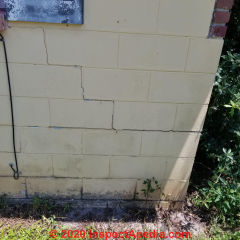 Step cracking in a concrete block foundation usually means settlement for homes that are located in a climate where freezing and frost heave are not concerns.
Step cracking in a concrete block foundation usually means settlement for homes that are located in a climate where freezing and frost heave are not concerns.
On 2020-07-13 by Jonathan
Looking at property in FL,
Cant really see the inside the property,
there are the attached step cracks on the left corner of the house,
there is also a small detach of the last block line along that corner all the way to the front,
what would you assess the cause of the problem is?
i saw a gutter on that corner where there are majority of the cracks,
any course of action to correct that?
On 2020-02-09 by (mod)
Beth,
I'm sorry, but no one can tell you what the asbestos hazard in your home might be or not be from your photos.
You might want to have materials tested by an asbestos test lab, but the real question is going to be how much dust and debris was produced In an occupied space and that contained asbestos, and at what levek and duration of exposure.
Even knowing that one of your samples does contain asbestos won't answer that question.
If the work is done and the area has been cleaned, It's going to be difficult to make even a crude Guess at what the conditions were previously.
Sometimes you can find a sample of acceptance desk that was not cleaned and although quantitative analysis is not accurate. One can at least screen that material for high levels of harmful particles.
On 2020-02-09 by Beth laflamme
And cement
On 2020-02-09 by Beth laflamme
On 2020-02-09 by Beth laflamme
Hi I was told that when they ripped my tiles up we should not of been here and hazmat should of been as are tiles contained aspestes 1972 it was built and this was a mantncee worker over 17 years ago also popcorn walls and ceiling and foundation and walls I need help I'd them please
On 2020-01-10 - by (mod) - possible foundation damage?
Mel
I'm sorry but I don't know what we are looking at here - a chimney base for a chimney that's settled, tipped or moved, or a jog in a foundation, or a foundation reinforcement or "pilaster';
Frankly you should (IMO) remember that as my mom used to say: YOU are the people with the money - in the case of buying a home, hundreds of thousands of dollars of it (even if it's coming from your bank).
If you were in a shoe store, would the salesman be nice to you?
This is a hundreds of thousands of dollars pair of shoes. What the heck is wrong with this picture?
When a seller refuses to allow you to investigate a possible concern at a property they're selling, If it were me I'd choose among:
1. find another home, figuring that the seller is unreasonably preventing me from discovering what may be only one of multiple worries and they've already told me in essence to take a walk
2. talk to your realtor who ought to talk some sense into the seller (or do they have something to hide?)
3. go a head and buy the home, but assuming that the true price of the home - what you're actually going to be paying - is increased substantially by the worst plausible case for foundation damage. In other words if I ask a question and am not permitted to obtain a reasonable answer I'm forced to assume the worst.
On 2020-01-10 by Melandharris
I have another picture from our inspector. Looks like shear failure but unsure
Hi everyone, we’re trying to buy a house but the sellers aren’t allowing us to send a free foundation inspector to evaluate some of the cracks in pictures taken by the home inspector. Can you all take a look to help us diagnose the type of issue (if any) and help us understand worst case scenarios for what type of damage the home may currently have or may have in the future as a result of these issues.
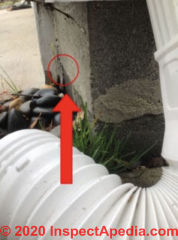
On 2019-03-02 17:29:01.492087 - by (mod) -
Your photo shows a cold pour joint in the concrete. See CONCRETE COLD POUR JOINTS https://inspectapedia.com/structure/Concrete_Cold_Pour_Joints.php
If the foundation is not set on and tied to the footing that might or might not be serious depending on the footing and foundation specifications - you need help from an architect or engineer who can examine the foundation plans and compare those with the as-built situation.
On 2019-03-02 by Jeff
Thanks for the quick response!
These were poured by a cement truck/pump I believe. Yes these are steel reinforced foundation walls.
A few other things we noticed yesterday on closer inspection.
1. There’s a long diagonal line which looks like a cold joint (photo attached).
2. One of the foundation wall “T-Walls” is not centered on the footing-It looks like it’s hanging off the edge.
3. The exterior walls are a max of 8 inches, but some are under that (Plans called for 8 which I believe is consistent with code)... Is there an acceptable margin?
Thanks again for the help!
IMAGE LOST by older version of Clark Van Oyen’s useful Comments code - now fixed. Please re-post the image if you can. Sorry. Mod.
On 2019-03-01 - by (mod) -
I'm not sure about applying the word "normal" but "common" fits - in that incompletely-mixed concrete pours can look like that in your photo.
Was this delivered by a concrete truck or mixed by hand?
Is this a steel reinforced concrete foundation wall?
On 2019-03-01 by Jeff
Hello,
We are building new construction in Wisconsin and the foundation walls were poured this week (I should note it was very cold (15 degrees F) on the day of the pour).
We noticed quite a bit of “honeycomb” on the foundation walls. Curious how normal this is or if I should be concerned. Happy to provide any additional information or more pictures. Thank you for the help!
IMAGE LOST by older version of Clark Van Oyen’s useful Comments code - now fixed. Please re-post the image if you can. Sorry. Mod.
...
Continue reading at FOUNDATION DAMAGE REPORTS or select a topic from the closely-related articles below, or see the complete ARTICLE INDEX.
Or see FOUNDATION CRACKS & DAMAGE GUIDE FAQs - questions & answers about foundation damage posted originally at the end of this page.
Or see these
Recommended Articles
- FOUNDATION CRACKS & DAMAGE GUIDE - home
- BLOCK FOUNDATION & WALL DEFECTS
- BRICK FOUNDATIONS & WALLS
- BULGE or LEAN MEASUREMENTS
- CONCRETE FOUNDATION, WALL, SLAB DEFECTS - home
- CONCRETE SLAB CRACK EVALUATION
- CONCRETE SHRINKAGE CRACKS
- CONTROL JOINT CRACKS in CONCRETE
- CRACK MONITORING METHODS
- DIAGONAL CRACKS in BLOCK FOUNDATIONS, WALLS
- DIAGONAL CRACKS in CONCRETE FOUNDATIONS, WALLS
- EARTHQUAKE DAMAGED FOUNDATIONS
- FLOOD DAMAGED FOUNDATIONS
- FOUNDATION CRACK DICTIONARY - what is the severity of foundation damage, what is its effect on the stability of the structure, and how urgently are foundation repairs needed?
- FOUNDATION DAMAGE by MATERIAL or INCLUSIONS
- FOUNDATION FAILURES by MOVEMENT TYPE: is the movement active or not, how is the foundation moving: bulging, leaning, settling, etc. ?
- FOUNDATION FAILURES by TYPE & MATERIAL: how does damage show up in different types of foundation material & what are the implications for collapse risk or repair need?
- FOUNDATION DAMAGE on SHALE
- FOUNDATION MOVEMENT ACTIVE vs. STATIC
- FOUNDATION SHRINKAGE vs EXPANSION vs SETTLEMENT
- FROST HEAVES, FOUNDATION, SLAB
- HORIZONTAL FOUNDATION CRACKS
- PYRRHOTITE INCLUSION CRACKING
- SHRINKAGE vs EXPANSION vs SETTLEMENT
- SINKHOLES & BUILDING DAMAGE
- THERMAL EXPANSION CRACKS in BRICK
- VERTICAL CRACKS in BLOCK WALLS
- VERTICAL FOUNDATION CRACKS
- FOUNDATION DAMAGE & REPAIR GUIDE - home page foundation damage assessment & repair procedures.
- FOUNDATION INSPECTION METHODS
- FOUNDATION REPAIR METHODS discusses alternative ways to fix a damaged foundation or floor slab crack or movement
- SOIL PROPERTIES & BUILDING FAILURES
Suggested citation for this web page
FOUNDATION CRACKS & DAMAGE GUIDE at InspectApedia.com - online encyclopedia of building & environmental inspection, testing, diagnosis, repair, & problem prevention advice.
Or see this
INDEX to RELATED ARTICLES: ARTICLE INDEX to BUILDING STRUCTURES
Or use the SEARCH BOX found below to Ask a Question or Search InspectApedia
Ask a Question or Search InspectApedia
Try the search box just below, or if you prefer, post a question or comment in the Comments box below and we will respond promptly.
Search the InspectApedia website
Note: appearance of your Comment below may be delayed: if your comment contains an image, photograph, web link, or text that looks to the software as if it might be a web link, your posting will appear after it has been approved by a moderator. Apologies for the delay.
Only one image can be added per comment but you can post as many comments, and therefore images, as you like.
You will not receive a notification when a response to your question has been posted.
Please bookmark this page to make it easy for you to check back for our response.
Our Comment Box is provided by Countable Web Productions countable.ca
Citations & References
In addition to any citations in the article above, a full list is available on request.
- [1] New York State Department of Engineering, correspondence. D. Hasbrouck, P.E. to DJF.
- "Concrete Slab Finishes and the Use of the F-number System", Matthew Stuart, P.E., S.E., F.ASCE, online course at www.pdhonline.org/courses/s130/s130.htm
- Sal Alfano - Editor, Journal of Light Construction*
- Thanks to Alan Carson, Carson Dunlop, Associates, Toronto, for technical critique and some of the foundation inspection photographs cited in these articles
- Terry Carson - ASHI
- Mark Cramer - ASHI
- JD Grewell, ASHI
- Duncan Hannay - ASHI, P.E. *
- Bob Klewitz, M.S.C.E., P.E. - ASHI
- Ken Kruger, P.E., AIA - ASHI
- Aaron Kuertz aaronk@appliedtechnologies.com, with Applied Technologies regarding polyurethane foam sealant as other foundation crack repair product - 05/30/2007
- Bob Peterson, Magnum Piering - 800-771-7437 - FL*
- Arlene Puentes, ASHI, October Home Inspections - (845) 216-7833 - Kingston NY
- Greg Robi, Magnum Piering - 800-822-7437 - National*
- Dave Rathbun, P.E. - Geotech Engineering - 904-622-2424 FL*
- Ed Seaquist, P.E., SIE Assoc. - 301-269-1450 - National
- Dave Wickersheimer, P.E. R.A. - IL, professor, school of structures division, UIUC - University of Illinois at Urbana-Champaign School of Architecture. Professor Wickersheimer specializes in structural failure investigation and repair for wood and masonry construction. *
- *These reviewers have not returned comment 6/95
- Quality Standards for the Professional Remodeling Industry, National Association of Home Builders Remodelers Council, NAHB Research Foundation, 1987.
- Quality Standards for the Professional Remodeler, N.U. Ahmed, # Home Builder Pr (February 1991), ISBN-10: 0867183594, ISBN-13: 978-0867183597
- Superior Walls of America, Ltd, 937 East Earl Road, New Holland, PA 17557, Phone: 1-800-452-9255, Fax: 717-351-9263. Website: http://www.superiorwalls.com/ Technical support:
Ed Helderman our Codes and Standards Manager. Email: ehelderman@superiorwalls.com or 717-351-9744
Robert Hare, Director of Technical Operations, rhare@superiorwalls.com, Tel: 717.351.9735
Thanks to Robert Hare for technical critique & content suggestions for this article - August 2010 - Superior Walls of America Builder Guideline Booklet MAN 42-9000 booklet, [local copy] web-search 09/01/2010 original source (indirect link): http://www.superiorwalls.com/faq.php?&answers=1&details=53
Technical Content Reviewers for Foundation Crack and Movement Damage Evaluation, Diagnosis, & Reporting
- InspectAPedia.com® - Daniel Friedman - Publisher & Editor.
- Daniel Friedman - ASHI Member (1986-2006) - building failures researcher.
- "Concrete Slab Finishes and the Use of the F-number System", Matthew Stuart, P.E., S.E., F.ASCE, online course at www.pdhonline.org/courses/s130/s130.htm
- Sal Alfano - Editor, Journal of Light Construction*
- Thanks to Alan Carson, Carson Dunlop, Associates, Toronto, for technical critique and some of the foundation inspection photographs cited in these articles
- Terry Carson - ASHI
- Mark Cramer - ASHI
- JD Grewell, ASHI
- Duncan Hannay - ASHI, P.E. *
- Bob Klewitz, M.S.C.E., P.E. - ASHI
- Ken Kruger, P.E., AIA - ASHI
- Aaron Kuertz aaronk@appliedtechnologies.com, with Applied Technologies regarding polyurethane foam sealant as other foundation crack repair product - 05/30/2007
- Bob Peterson, Magnum Piering - 800-771-7437 - FL*
- Arlene Puentes [Website: www.octoberhome.com ] , 845-339-7984, is an ASHI member and a licensed home inspector in Kingston, NY, and has served on ASHI national committees as well as HVASHI Chapter President. Ms. Puentes can be contacted at ap@octoberhome.com.
- Greg Robi, Magnum Piering - 800-822-7437 - National*
- Dave Rathbun, P.E. - Geotech Engineering - 904-622-2424 FL*
- Ed Seaquist, P.E., SIE Assoc. - 301-269-1450 - National
- Dave Wickersheimer, P.E. R.A. - IL, professor, school of structures division, UIUC - University of Illinois at Urbana-Champaign School of Architecture. Professor Wickersheimer specializes in structural failure investigation and repair for wood and masonry construction. * Mr. Wickersheimer's engineering consulting service can be contacted at HDC Wickersheimer Engineering Services. (3/2010)
- *These reviewers have not returned comment 6/95
Technical Edits, Changes, Amendments to This Document
- 09/01/2010 technical edits
- 09/23/2008 adding crawl space safety warnings and crawl space dyrout procedures
- 06/09/2010 adding flood damage to foundations - a flood damage investigation case suggests pre-existing cracks
- 08/03/2007 adding text, illustrations, content, organization changes, citations to authority
- 06/07/2007 adding text, illustrations, content
- 5/30/2007 editing to add content on foundation crack repair
- 9/23/2006 editing to clarify text and add content; Technical review (partial) by Arlene Puentes.
- 4/17/2006 editing to clarify text in several sections.
- 2/6/99 editing updates, soliciting additional reviews
- 2/3/99 Converted working text file to MSWord97 .doc and .htm files for easier review on Internet
- 6/26/95 text updates per comments from Al Carson, Terry Carson, Mark Cramer 6/16/95 text updates for Calgary July 1995
- cc's sent to reviewers
- 3/28/95 uploaded to ASHI's Internet site - asfoun01.txt
- 11/19/93 Ed Seaquist - telecon 11/19/93, likes, will write up one of our sections for my/our target of series of journal articles or a book.
- © Dan Friedman 1999, original 1992 All Rights Reserved -- foundation.htm
- Masonry structures: The Masonry House, Home Inspection of a Masonry Building & Systems, Stephen Showalter (director, actor), DVD, Quoting:
Movie Guide Experienced home inspectors and new home inspectors alike are sure to learn invaluable tips in this release designed to take viewers step-by-step through the home inspection process. In addition to being the former president of the National Association of Home Inspectors (NAHI), a longstanding member of the NAHI, the American Society of Home Inspectors (ASHI), and the Environmental Standard Organization (IESO), host Stephen Showalter has performed over 8000 building inspections - including environmental assessments. Now, the founder of a national home inspection school and inspection training curriculum shares his extensive experience in the inspection industry with everyday viewers looking to learn more about the process of evaluating homes. Topics covered in this release include: evaluation of masonry walls; detection of spalling from rebar failure; inspection of air conditioning systems; grounds and landscaping; electric systems and panel; plumbing supply and distribution; plumbing fixtures; electric furnaces; appliances; evaluation of electric water heaters; and safety techniques. Jason Buchanan --Jason Buchanan, All Movie Review - Avongard FOUNDATION CRACK PROGRESS CHART [PDF] - structural crack monitoring
- Building Failures, Diagnosis & Avoidance, 2d Ed., W.H. Ransom, E.& F. Spon, New York, 1987 ISBN 0-419-14270-3
- Building Pathology, Deterioration, Diagnostics, and Intervention, Samuel Y. Harris, P.E., AIA, Esq., ISBN 0-471-33172-4, John Wiley & Sons, 2001 [General building science-DF] ISBN-10: 0471331724 ISBN-13: 978-0471331728
- Building Pathology: Principles and Practice, David Watt, Wiley-Blackwell; 2 edition (March 7, 2008) ISBN-10: 1405161035 ISBN-13: 978-1405161039
- Diagnosing & Repairing House Structure Problems, Edgar O. Seaquist, McGraw Hill, 1980 ISBN 0-07-056013-7 (obsolete, incomplete, missing most diagnosis steps, but very good reading; out of print but used copies are available at Amazon.com, and reprints are available from some inspection tool suppliers).
Ed Seaquist was among the first speakers invited to a series of educational conferences organized by D Friedman for ASHI, the American Society of Home Inspectors, where the topic of inspecting the in-service condition of building structures was first addressed. - Domestic Building Surveys, Andrew R. Williams, Kindle book, Amazon.com
- Defects and Deterioration in Buildings: A Practical Guide to the Science and Technology of Material Failure, Barry Richardson, Spon Press; 2d Ed (2001), ISBN-10: 041925210X, ISBN-13: 978-0419252108. Quoting:
A professional reference designed to assist surveyors, engineers, architects and contractors in diagnosing existing problems and avoiding them in new buildings. Fully revised and updated, this edition, in new clearer format, covers developments in building defects, and problems such as sick building syndrome.
Well liked for its mixture of theory and practice the new edition will complement Hinks and Cook's student textbook on defects at the practitioner level. - Guide to Domestic Building Surveys, Jack Bower, Butterworth Architecture, London, 1988, ISBN 0-408-50000 X
- "Avoiding Foundation Failures," Robert Marshall, Journal of Light Construction, July, 1996 (Highly recommend this article-DF)
- "A Foundation for Unstable Soils," Harris Hyman, P.E., Journal of Light Construction, May 1995
- "Backfilling Basics," Buck Bartley, Journal of Light Construction, October 1994
- "Inspecting Block Foundations," Donald V. Cohen, P.E., ASHI Reporter, December 1998. This article in turn cites the Fine Homebuilding article noted below.
- "When Block Foundations go Bad," Fine Homebuilding, June/July 1998
- Masonry structures: The Masonry House, Home Inspection of a Masonry Building & Systems, Stephen Showalter (director, actor), DVD, Quoting:
Movie Guide Experienced home inspectors and new home inspectors alike are sure to learn invaluable tips in this release designed to take viewers step-by-step through the home inspection process. In addition to being the former president of the National Association of Home Inspectors (NAHI), a longstanding member of the NAHI, the American Society of Home Inspectors (ASHI), and the Environmental Standard Organization (IESO), host Stephen Showalter has performed over 8000 building inspections - including environmental assessments. Now, the founder of a national home inspection school and inspection training curriculum shares his extensive experience in the inspection industry with everyday viewers looking to learn more about the process of evaluating homes.
Topics covered in this release include: evaluation of masonry walls; detection of spalling from rebar failure; inspection of air conditioning systems; grounds and landscaping; electric systems and panel; plumbing supply and distribution; plumbing fixtures; electric furnaces; appliances; evaluation of electric water heaters; and safety techniques. Jason Buchanan --Jason Buchanan, All Movie Review - In addition to citations & references found in this article, see the research citations given at the end of the related articles found at our suggested
CONTINUE READING or RECOMMENDED ARTICLES.
- Carson, Dunlop & Associates Ltd., 120 Carlton Street Suite 407, Toronto ON M5A 4K2. Tel: (416) 964-9415 1-800-268-7070 Email: info@carsondunlop.com. Alan Carson is a past president of ASHI, the American Society of Home Inspectors.
Thanks to Alan Carson and Bob Dunlop, for permission for InspectAPedia to use text excerpts from The HOME REFERENCE BOOK - the Encyclopedia of Homes and to use illustrations from The ILLUSTRATED HOME .
Carson Dunlop Associates provides extensive home inspection education and report writing material. In gratitude we provide links to tsome Carson Dunlop Associates products and services.


